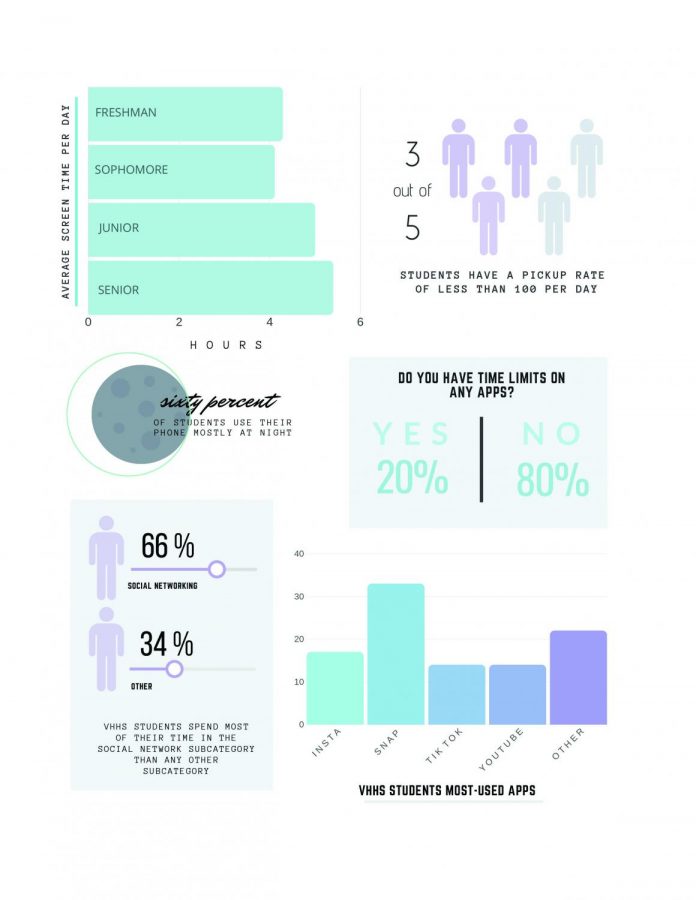Too much screentime?
An image of graphs showcasing different statistics about students and their phones
The first thing we hear when we wake up is the shrill ring of the alarm on our phones. Then, during the day, we shuffle through Google Drive tabs on our school computers or have our ears plugged while streaming music on our phones. Even when we come home, we are found avidly scrolling through social media or typing away at a homework assignment.
Any and every part of students’ lives are embedded with screens, but a TSP conducted survey helps to demonstrate the extent. The survey of 127 students showed that 38.9% of people spend 3 to 5 hours on their phone daily and another 22.2% spend 5 to 7 hours on their phones. Despite being students, as well as being involved in extracurricular activities, the majority of students still spend a large block of their time behind their screens.
Mr. Cory Smith, English teacher, talked about an activity he does every year with his freshman where they anonymously share their screen time over the last ten days and noted how startling his students’ reactions were.
“If someone has the highest hours on an app when we share with the class they will get so excited. They will be like, ‘Nobody beats me on Snapchat with 30 hours!’” Smith explained.
However, Senior Riya Rathod (12) justified these statistics to an extent and said, “My screen time is about 4 hours per day… but this [the survey results] doesn’t surprise me. People fall asleep on their phones watching YouTube videos all the time.”
Clearly, teenagers are using their phones and other types of technology all day, but that is very general. With the millions of apps on the App Store, the possibilities are endless for the ways people use their phones. In some instances, these devices are used for work, but it seems most of the time phones are used more for enjoyment.
The survey also showed that 66% of people reported using their phones mostly for social networking, alongside 26.4% saying they use it mostly for Entertainment. The results read that the highest used apps are Snapchat and Instagram, this is understandable.
It is clear that phones serve more as a source of talking to others and amusing teenagers rather than being utilized for learning purposes.
Phones have been developed rapidly over the years and have lots of different features. They can research new topics and create anything from a written message to an entire app; however, from the survey results, teenagers seem to lean towards apps which are used for socializing and enjoyment.
The survey shows how teens are using their phones copiously, but, especially in this day and age of technology, some say it only makes sense that teens are using their phones so avidly.
Rathod explains that the extent to which teens use their phones is extreme, but also argued that, “We also use our phones to communicate in ways where it wasn’t possible in the past.”
Smith explained the new culture around phones and how they are used constantly when he said, “It has changed the framework of homework and student life…gosh, past that, they play into the way you communicate and interact with other individuals.”
Apart from how screen time is being distributed, the usage across ages came up as a trend. Between grade level, the average screen time usage is quite close with the averages being 4.3 hours for freshman, 4.1 hours for sophomores, 5 hours for juniors, and 5.4 hours for seniors.
There is some fluctuation, but Riya Rathod summed up the screen time usage across the grade level when she explained that, “We are basically all involved in the same things.”
Smith justified his screen time and compared his to teenagers. Most of his apps were used for practical purposes such as FaceTiming his family while he was away or keeping up to date on the News app. However, there is some overlap with entertainment apps regardless of generation as he enjoys using the ESPN app.
It is clear there are stark differences in the way and extent that generations use their phones due to priorities and familiarity with new tech.
With having kids and having a full time job, Smith explained that, “With the very few spare moments I get nowadays I obviously can’t just play Angry Birds anymore. There are different priorities.”
But when talking about even older generations Smith still believed that there were clear divides. He joked about this and said, “I do think there is a clear generational split…like there are other teachers that I think you’d look at it [their screen time] and be like ‘Do you even own a phone?’”
Overall, while used in unique ways and to different degrees, screens are an integral part of people’s lives across the board. It is clear that teenagers are using them more due to the fact they grew up around technology. However, older generations screen time is comparable, but just used for more pragmatic approaches.

